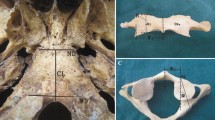Abstract
Purpose
The aim of this paper is to discuss the problems of craniocervical instability and craniocervical fusion in infancy. Despite the relative frequency of carniovertebral joint malformations, actual instability is quite rare in infancy.
Methods
An infant 8 months of age presented with tetraparesis and sleep apnea due to a complex malformation of her craniovertebral joint. An initial attempt at conservative treatment using a rigid neck collar failed, so the patient was surgically managed by the onlay placement of two autologous rib grafts. The rigid collar was maintained for 5 months.
Results
Both rib grafts progressively reabsorbed within a few months, while the clinical deficits recurred. Reoperation consisted of occipitocervical interposition of two robust struts of banked cadaveric adult fibula. This time, the skull appeared mature enough to allow immobilization by the halo system. Adequate occipitocervical fusion was eventually achieved, and the patient fully recovered.
Conclusions
To the best of our knowledge, there is no other reported case of an infant undergoing craniovertebral fusion using cadaveric adult bone. When screw placement is not considered advisable to manage small infants, appropriate stability may be obtained using struts of robust cadaveric bone. A meticulous carpentry technique with graft interposition under compression and adequate postoperative immobilization remains mandatory.




Similar content being viewed by others
References
Ahmed R, Traynelis VC, Menezes AH (2008) Fusions at the craniovertebral junction. Childs Nerv Syst 24:1209–1224
Brockmeyer DL, Brockmeyer MM, Bragg T (2011) Atlantal hemi-rings and craniocervical instability: identification, clinical characteristics, and management. J Neurosurg Pediatr 8:357–362
Menezes AH (2008) Craniocervical developmental anatomy and its implications. Childs Nerv Syst 24:1109–1122
Menezes AH (2012) Craniocervical fusions in children. A review. J Neurosurg Pediatr 9:573–585
Menezes AH, Traynelis VC (2008) Anatomy and biomechanics of normal craniovertebral junction (a) and biomechanics of stabilization (b). Childs Nerv Syst 24:1091–1100
Menezes AH, Vogel TW (2008) Specific entities affecting the craniocervical region: syndromes affecting the craniocervical junction. Childs Nerv Syst 24:1155–1163
Tauchi R, Imagama S, Ito Z, Ando K, Hirano K, Muramoto A, Matsui H, Kato F, Yukawa Y, Sato K, Kanemura T, Yoshihara H, Kamiya M, Matsuyama Y, Ishiguro N (2012) Complications and outcomes of posterior fusion in children with atlantoaxial instability. Eur Spine J 21:1346–1352
Anderson RCE, Ragel BT, Mocco J, Bohman L-E, Brockmeyer DL (2007) Selection of a rigid internal fixation construct for stabilization at the craniovertebral junction in pediatric patients. J Neurosurg Pediatr 107:36–42
Gluf WM, Brockmeyer DL (2005) Atlantoaxial transarticular screw fixation: a review of surgical indications, fusion rate, complications, and lessons learned in 67 pediatric patients. J Neurosurg Spine 2:164–169
Goel A (2008) Craniovertebral stabilization. J Neurosurg Pediatr 1:173–175
Goel A, Muzumdar D, Dange N (2007) Syringomyelia in infants secondary to mobile congenital atlantoaxial dislocation. Pediatr Neurosurg 43:15–18
Jea A, Taylor MD, Dirks PB, Kulkarni AV, Rutka JT, Drake JM (2007) Incorporation of C-1 lateral mass screws in occipitocervical and atlantoaxial fusions for children 8 years of age or younger. Technical note. J Neurosurg 107(2):178–183. doi:10.3171/PED-07/08/178
Thiryayi WA, Alakandy LM, Leach PA, Cowie RA (2007) Craniocervical instability in an infant with partial sacral agenesis. Acta Neurochir (Wien) 149:623–627
Klimo P, Astur N, Gabrick K, Warner WC, Muhlbauer MS (2013) Occipitocervical fusion using a contoured rod and wire construct in children: a reappraisal of a vintage technique. J Neurosurg Pediatr 11:160–169
Debernardi A, D’Aliberti G, Talamonti G, Villa F, Piparo M, Collice M (2011) The craniovertebral junction area and the role of the ligaments and membranes. Neurosurgery 68:291–301
Goel A, Laheri V (1994) Plate and screw fixation for atlanto-axial subluxation. Acta Neurochir (Wien) 129:47–53
Talamonti G, D’Aliberti GA, Debernardi A, Picano M (2012) Paediatric spinal Langerhans cell histiocytosis requiring corpectomy and fusion at C7 and at Th8–Th9 levels. BMJ Case Rep. doi:10.1136/bcr-2012-007660
Harms J, Melcher RP (2001) Posterior C1-C2 fusion with polyaxial screw and rod fixation. Spine 26:2467–2471
Hood B, Hamilton DK, Smith JS, Dididze M, Shaffrey C, Levi AD (2014) The use of allograft and recombinant human bone morphogenetic protein for instrumented atlantoaxial fusions. World Neurosurg. doi:10.1016/j.wneu.2013.01.083
Campana V, Milano G, Pagano E, Barba M, Cicione C, Salonna G, Lattanzi W, Logroscino G (2014) Bone substitutes in orthopaedic surgery: from basic science to clinical practice. J Mater Sci Mater Med. doi:10.1007/s10856-014-5240-2
Hillard VH, Fassett DR, Finn MA, Apfelbaum RI (2009) Use of allograft bone for posterior C1–2 fusion. J Neurosurg Spine 11:396–401
Lindley TE, Dahdaleh NS, Menezes AH, Abode-Iyamah KO (2011) Complications associated with recombinant human bonemorphogenetic protein use in pediatric craniocervical arthrodesis. Clinical Article. J Neurosurg Pediatr 7:468–474
Shapiro S (1996) Banked fibula and the locking anterior cervical plate in anterior cervical fusions following cervical discectomy. J Neurosurg 84:161–165
Conflict of interest
The authors declare that they have no conflict of interest.
Author information
Authors and Affiliations
Corresponding author
Rights and permissions
About this article
Cite this article
Talamonti, G., D’Aliberti, G. & Debernardi, A. Craniovertebral fusion in an infant using struts of banked adult bone. Childs Nerv Syst 32, 753–757 (2016). https://doi.org/10.1007/s00381-015-2909-x
Received:
Accepted:
Published:
Issue Date:
DOI: https://doi.org/10.1007/s00381-015-2909-x




